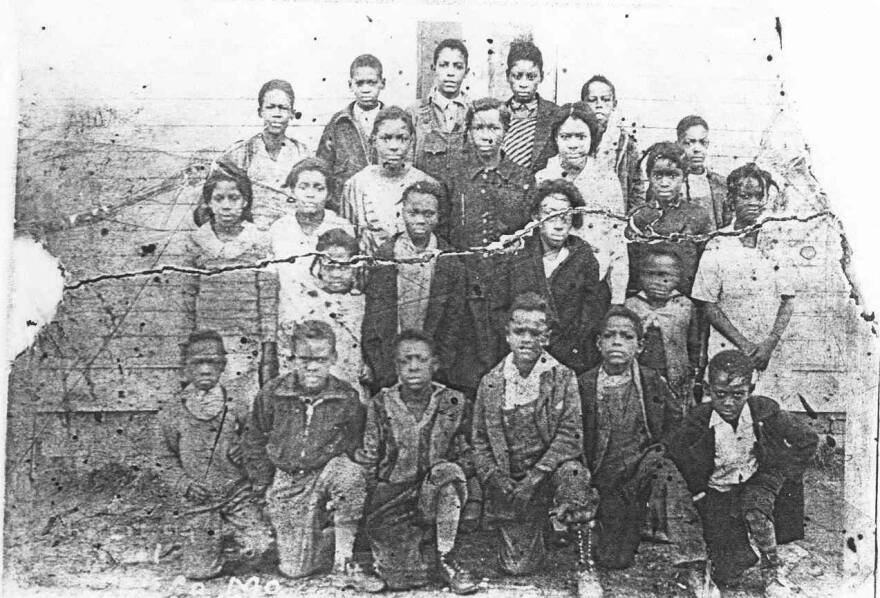About 80 years ago, Curtis Johnson would walk 3 miles to a log schoolhouse in Chesterfield to learn math and how to read and write. On his way to class, he used to pass another school building that he could not attend because he's Black.
“It was all brick, [with] heat, bathrooms on the inside during that time,” said Johnson, 85.
Johnson’s one-room school was not like that. It had a tiny gold stove to help heat the structure, and children would have to step outside to use the restroom. Still, Johnson has fond memories of African Schoolhouse #4, where he attended first and second grades.

On Saturday, St. Louis County reopened the schoolhouse in Faust Park’s Historic Village, after nearly a year of preservation work.
Black children in Chesterfield attended the school from 1894 until 1950. It was built for $600 on Wild Horse Creek Road after Black residents sued the Chesterfield School District.
In the late 1800s, the Missouri Constitution said that education was to be free for residents ages 5 to 21, but Black schools had extra attendance stipulations during that time. At least 20 students had to be enrolled for a school to operate. Chesterfield School District refused to build a school for Black students even though there were enough students to fill the classroom.
Black Chesterfield residents recognized the importance of education and how to use it as a tool against oppression, St. Louis County Executive Sam Page said.
“It's hard to imagine a time when education wasn't a fundamental right for everyone,” Page said, calling the school “an extraordinary act of defiance.”
After the school closed, the property was sold and converted into a one-car garage. St. Louis County Parks officials kept their eyes on the building for decades, and in 2021, the property owner agreed to give it to the parks department. County officials said the structure was dilapidated but surprisingly had survived the Great Flood of 1993 and termites.
St. Louis County Parks Foundation raised $30,000 to move Missouri’s oldest one-room Black schoolhouses to Faust Park and restore it. The county preserved about 90% of the original structure by salvaging logs, planks and even old school boards with chalk-written math lessons. To bring the building to life, the county replaced the roof, added a scarlet red door and matching window shutters, painted the vinyl siding white and furnished the inside with included replica school desks and books from the early 1900s.
“Over the last 130 years, the schoolhouse persevered, the people educated here persevered, and now their story will be persevered in the new space as we remember them,” said St. Louis County Councilman Mark Harder, R-Ballwin, who represents Chesterfield.

‘We have come a long way’
When Doris Frazier, who was a substitute teacher at African Schoolhouse #4, stepped into the restored building for the first time in over 50 years, she said it looked just like it had when she taught there decades ago.
As she walked through the 15-by-19-foot room in amazement, she joyfully asked visitors who came in with her, "Could you imagine going to school like this?"

Frazier taught first through eighth grade reading, writing and math.
“To see the progress of the educational system has really blessed my heart,” said Frazier, 91. “That was my main thing, even in this little schoolhouse: that children become very intelligent, to speak well.”
Frazier said she's always had a strong desire to teach Black children in and out of the classroom setting. She also taught piano lessons, directed choirs and traveled around the world singing with her family group.
Frazier is ecstatic to have helped restore and bring her old place of employment back to life, but she is more elated to witness how far her legacy of education has reached through the descendants of children who attended African Schoolhouse #4.
“Some of the kids standing here today have gone to college, some of them have their doctoral degrees and are just doing wonderful, and I'm very proud of that,” she said to hundreds attending the opening Saturday in Faust Park. “That's what I was interested in, that our kids would have the same education as any other kid.”
As Frazier looks back at her years teaching in a one-room schoolhouse, she said that fighting for the equal education of Black children was hard and that there is still more to do.
“I'm very pleased to know that we have come a long way,” Frazier said. “But we haven't gone far enough.”




